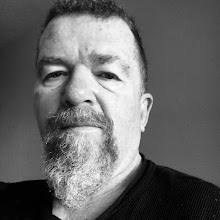Thermal Typing Madness


Post-Script: Today I took the EP-20 in its carry bag up to the cigar store ("up" in ABQ meaning uphill, easterly, closer to the Sandia mountains) and had a chance to work with it, along with the roll of 8.5" wide thermal fax paper. Nestled in my lap, the paper sat comfortably on my knees behind the machine, though it would work better with some bracket to keep the paper from falling on the floor should I move the wrong way. Yes, I do have the wooden paper roll holder, but it's too bulky to take in the little carry bag with the machine. I'll therefore have to fashion some kind of wire bracket thingie sometime soon.
I had to remember to give the paper a "service loop", so it would be free to feed through the machine during a carriage return, else the line spacing can get wonky.
In actual practice, I would keep the machine powered off (I was using D-cells) until some thought struck me, at which point I'd turn it on and start typing. The correction feature of the 16-character LCD display is pretty handy for ironing out most typos, though a few snuck through anyway.

I thought I was going to do some profound writing, but being seated next to the TV in the cigar lounge that was blaring some obnoxious court show, it was all I could do to remember my own name. I did end up with some journal notes, not a total waste of time.
After I got home with a bit of writing, ready to archive in my notebooks, I figured out the best way to bind these long scrolls of paper is to hole-punch the bottom edge, crosswise to the paper along the 8-1/2" width, then insert in a 3-ring binder and fan-fold the paper scroll so it fits snuggly in the binder. It can then be unfolded to be read. The width is enough to permit being punched by two of the three holes in a 3-ring binder punch, sufficient to be securely bound.
I don't think this little thermal typewriter is a real substitute for a good manual typewriter, but what it has going for it is: light weight; small size, nearly dead-quiet operation and quick response between pressing a key and seeing the characters printed - better than most daisy wheel typewriters I'd estimate. Its negatives are being electric (though the D-cell batteries work well enough) and having to use thermal paper; the original carbon film ribbon cartridges are not being manufactured, and online are exorbitantly expensive; another reason to treat it as a thermal-only machine.
Here's a printout from Ted Munk's Canon Typestar 4 thermal printing typewriter, that I tested when in Mesa, AZ last week. The Brother EP-20 predates the Typestar machines. Note the Typestar line offers more fonts and font sizes than the little Brother machine:

For more details about this machine, see the video:
Labels: Brother EP-20, Ted Munk, thermal typewriters

10 Comments:
Well, let's see - the batteries in that Typestar that powered the print head but not the screen were fresh in 2015, and I usually rotated them out between the handful of thermal wedgies I have as needed.. so maybe 3 years of battery life with not-too-hard use? :D
Neat little thermal writer. For longer permanence there is always scanning to a digital file or copying.
Very nice, I love it.
very good article...
Keep up the good work
Very nice article
great photos
Very nice information.
This is great blog keep it up.thermal fax machinesI read all your article and I really like it.Thanks for sharing.
thermal fax machines in hyderabad
Needed to compose you a very little word to thank you yet again regarding the nice suggestions you’ve contributed here.
Thermal Management Services in India, USA, Europe, Mexico
Post a Comment
<< Home